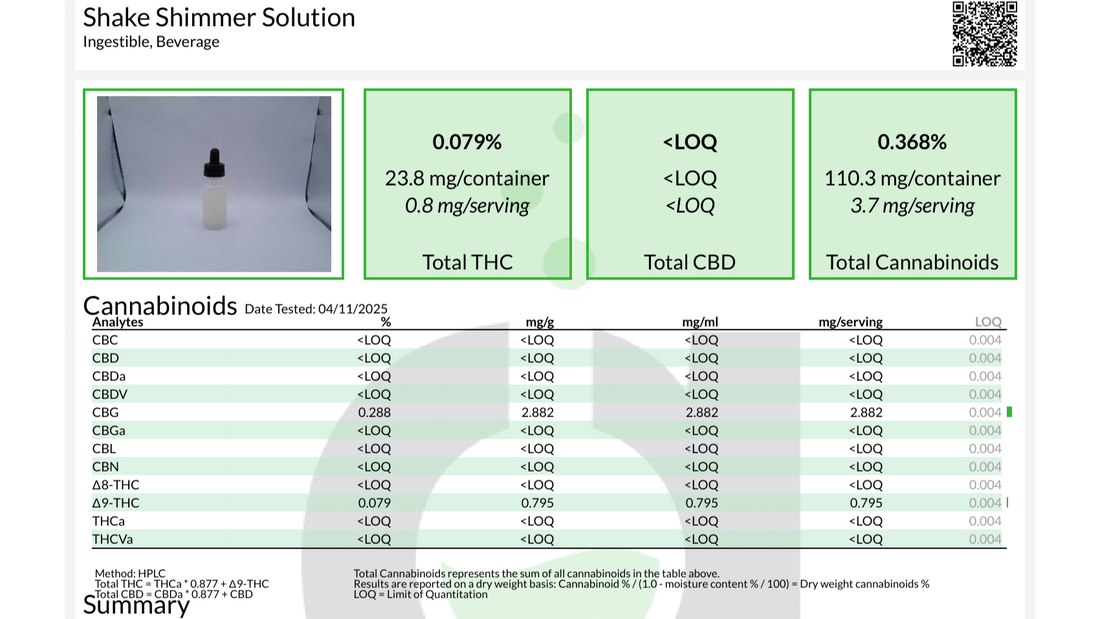You don’t need a lab coat to read a cannabis beverage COA (Certificate of Analysis). You just need a quick process. Before you crack a FRESH PRESS can or add a few drops of SHAKE to your mocktail, spend five minutes verifying the batch’s lab report. This simple habit protects your vibe, your health, and your wallet. Here’s the clean, urban guide to decoding a cannabis beverage COA—fast.
What a COA is—and why it matters
A COA is a lab-issued document that shows what’s in a product and what’s not. For drinks and drops, it confirms cannabinoid potency, checks for contaminants, and ties results to a specific batch. When the COA matches the label, you can sip with confidence. When it doesn’t, you’ve got questions to ask before you pour. Look for COAs linked by a QR code on the package or posted in a brand’s transparency hub, like 23rd State’s public COAs page.

Find it fast: QR-to-COA and batch basics
- Scan the product’s QR code. It should open a direct link to a viewable COA, not just a homepage.

- Match the batch/lot number on the COA to the number on your can or bottle. No match, no trust.
- Check the report date. COAs should be recent and reflect the batch in your hand.
- If you’re browsing first, head to the COAs page or the relevant product page—e.g., SHAKE Edible Glitter Drops or FRESH PRESS—and look for the latest batch link.
Step 1: Verify the header (the COA’s ID card)
Start at the top of the report.
- Product name and form: beverage, enhancer/drops, flavor.
- Batch/lot number: must mirror your label.
- Sample and report dates: fresh is best.
- Lab name and accreditation: look for ISO/IEC 17025 accreditation (commonly noted by an accreditor like A2LA). That standard signals the lab’s methods and quality system are audited. Learn more about ISO/IEC 17025 accreditation for cannabis testing at A2LA’s program page.
- Chain of custody: who delivered what, when. If anything is missing here—especially the batch number or lab details—pause your purchase or reach out to support.
Step 2: Potency panel—does the math check out?
For drinks and drops, potency is reported in milligrams (mg). You’ll often see results formatted two ways:
- mg per serving
- mg per container (can, bottle, or full dropper)
What to check:
- Serving math: If the label says 5 mg THC per serving and 10 mg per 12 oz can, the COA should reflect the same ballpark with a small tolerance. In Minnesota, hemp-derived THC beverages are capped at 5 mg THC per serving and 10 mg THC per container; consumers can review the state’s potency limits on the Office of Cannabis Management site here. Brands should label serving counts clearly.
- Total vs. individual cannabinoids: Drinks may include THC with minor cannabinoids like CBG. For example, SHAKE lists 1 mg THC and 3 mg CBG per dropper. Your COA should list each cannabinoid and a total where relevant.
- Units: Beverages typically show mg/can; enhancers show mg/mL and mg per dropper. Confirm that the unit on the COA matches the way you dose at home.
- Decarb math: Some COAs show THCa and Δ9-THC separately; “Total THC” accounts for conversion. Drinks made with water-compatible emulsions should primarily show Δ9-THC. If the potency panel is wildly off from the label, contact the brand with the COA link before consuming.
Step 3: Safety first—scan the contaminant panels
Good COAs include full-panel testing that screens for common risks. Key sections to review:
- Heavy metals: lead (Pb), arsenic (As), cadmium (Cd), mercury (Hg). Results should be “ND” (not detected) or well below action limits. AOAC publishes cannabis-specific performance requirements for heavy metals methods—proof that standardized approaches exist for this exact use case. See AOAC SMPR 2020.001 here.
- Residual solvents: relevant if concentrates were used upstream. Look for “ND” or “pass.”
- Microbials and pathogens: total yeast and mold, E. coli, Salmonella. These should pass and be below limits.
- Mycotoxins and pesticides: particularly important for broader supply chains. Minnesota’s Office of Cannabis Management publishes technical standards outlining what licensed labs must test and how they report it; it’s a solid reference point for what a thorough beverage COA should cover. Explore those standards here.
Step 4: Learn the abbreviations so you can move faster
COAs love shorthand. A few you’ll see often:
- ND: Not Detected (below the lab’s detection limit)
- LOQ/LOD: Limit of Quantitation/Detection (the smallest amount the method can reliably measure)
- Pass/Fail: Whether the result meets state or internal limits
- RPD/Recovery: Quality-control checks that indicate whether the measurement behaved as expected Reading these once makes every future COA a two-minute skim.
Step 5: Optional panels—nice-to-know vs need-to-know
- Terpenes: Not required for beverages but useful if flavor and effect profiles matter to you.
- Water activity/pH: Sometimes included; low water activity supports shelf stability.
- Homogeneity: For multi-serving containers, this shows the active ingredient is distributed evenly. Optional data can help you choose between flavors or formats, but safety and potency are the priorities.
Step 6: Red flags to watch—no sparkle lost
- QR code goes nowhere or opens a generic homepage.
- Batch number on the COA doesn’t match your package.
- Potency only: no contaminants panel at all.
- No lab accreditation noted and no contact info.
- Formatting looks edited; numbers are rounded in ways that hide precision.
- Results are ancient (many months old) and don’t match a fresh batch on shelf.
- Units mismatch (mg/mL vs mg per can) that make the label look higher than the COA. When in doubt, ask the brand to send the correct COA. Good operators want you to see it.
Quick dosing math for drops—set your baseline
Enhancers like SHAKE list dosage per dropper. If a COA reports, for example, 1 mg THC per mL and the dropper is 1 mL, that’s 1 mg per full dropper. Want 2 mg in a spritz? Use two droppers. Hosting mixed tolerances? Build everyone’s drink at their comfort level, then sparkle it their way. Practical, precise, and pretty.
Keep, store, and refresh your receipts
- Save the COA link or PDF with your order confirmation.
- Re-check the COA when you replenish; every batch gets its own report.
- Store products per label—cool, dark, upright caps—to preserve quality. Find general care tips in 23rd State’s FAQ.
What “good” looks like: a 60-second checklist
- QR-to-COA works; batch numbers match.
- Lab shows ISO/IEC 17025 accreditation; contact details listed. See A2LA’s explainer.
- Potency in mg/serving and mg/container aligns with the label and local rules. Minnesota’s consumer overview on limits is here.
- Full safety panels (metals, microbials, residual solvents where relevant) show “pass” or “ND.” Method expectations are outlined by standards bodies like AOAC.
- COA date is current for the batch you’re holding.
FAQs
Do all states require the same tests? No. Requirements vary, but many regulators align on core safety panels and potency verification. Minnesota publishes clear testing and reporting standards you can reference here.
Is lab accreditation really that important? Yes. ISO/IEC 17025 accreditation signals a lab’s competence has been independently assessed. It doesn’t make results perfect, but it increases trust. Details here: A2LA’s accreditation program.
What about edible glitter in drinks—is it safe? If it’s labeled edible and uses food-grade pigments, yes. 23rd State discloses ingredients on product pages, and the FDA advises using only decorations labeled “edible” with ingredient lists. When in doubt, check labels.

Do standards exist for how COAs should look? Industry groups are actively shaping that. ASTM’s cannabis committee is developing guidance specific to COA content and format; see the current work item overview here.
The 23rd State way to sip smarter
Transparency is a flex. Start your ritual on the right note: scan the code, skim the COA, then pour with confidence. If you want a precise, microdose-friendly upgrade, explore our Drink Enhancers and build your moment with SHAKE. Craving a ready-to-sip option? Check the latest drops in THC Beverages and look for the matching COA before you hit checkout. Five minutes, zero guesswork—maximum glow.


